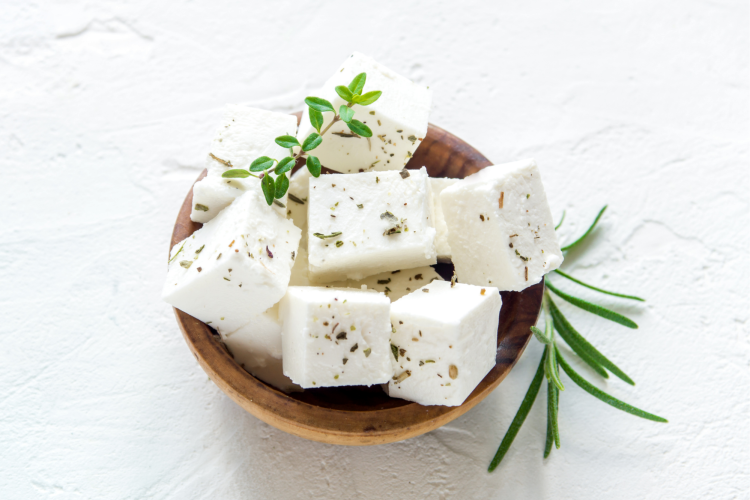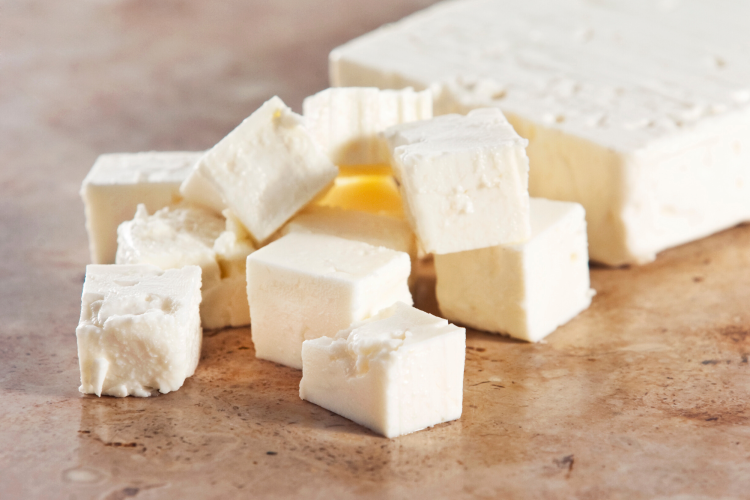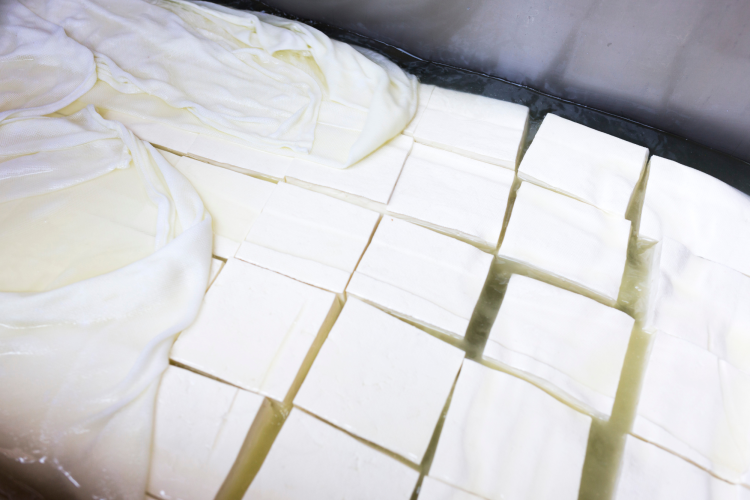A Guide to Feta Cheese in 2025

Feta cheese is a centuries-old cheese with a rich history and a unique flavor profile that sets it apart from the rest. It has been a staple in Mediterranean kitchens for generations and continues to be loved for its versatility in everyday cooking.
But what exactly makes feta so special and is it worth the hype? In this guide, we explore feta’s origins, how it's made and the best ways to enjoy it.
Jump to Section
- What Is Feta Cheese?
- The Best Ways to Eat Feta Cheese
- How To Make Feta Cheese at Home
- Best Feta Cheese Recipes
- Is Feta Cheese Healthy?
- Feta Cheese FAQs
What Is Feta Cheese?
The History of Feta Cheese

Feta is considered one of the oldest cheeses still in existence. Its story dates back to the Byzantine Empire and some even tie its origins to ancient Greek mythology.
According to legend, the Cyclops Polyphemus was the first to craft a version of this cheese using sheep’s milk. Historical artifacts from the 6th century BC in Delphi also reference early methods of cheese-making that resemble today's feta production.
The name “feta” itself has Italian roots, derived from fetta, meaning “slice,” which likely references the way the cheese is traditionally served. The word made its way into Greek in the 17th century and stuck, fitting for a cheese often cut into thick, savory slabs.
Over time, feta cheese became synonymous with Greek identity, especially with regions like Crete, where it’s deeply tied to local food traditions.
What Type of Cheese is Feta Cheese?

At its core, feta cheese is a brined white curd cheese traditionally crafted from sheep's milk or a blend of sheep and goat's milk. It has a creamy but crumbly texture and a salty, tangy flavor.
Often a staple in Mediterranean dishes, it's a versatile ingredient that works just as well sprinkled over salads as it does baked into savory pies or whipped into dips.
The authentic Greek version must contain at least 70% sheep's milk, with goat's milk making up no more than 30% of the mixture. This specific combination creates the ideal balance of creaminess and tang that defines true feta.
In the Greek countryside, these animals typically graze on wild herbs like thyme, oregano and sage, which grow in the mountainous regions of Greece. This natural diet gives the milk and consequently the feta, its distinctive flavor and rich character. The higher the goat’s milk content, the firmer and sharper the taste becomes.
While traditional feta relies on sheep and goat milk, some producers outside of Greece use cow’s milk or a blend to create milder, more approachable versions of the cheese. These alternatives may lack the bold tang of authentic feta but offer a gentler flavor that suits a variety of palates and recipes.
To make feta, pasteurized milk is cooled and mixed with rennet, an enzyme usually sourced from young animals, which helps the milk coagulate. After the curds form, the mixture is sliced, drained and packed into molds. Then comes the salting process, a crucial step in feta production. Coarse-grain salt is generously sprinkled over the cheese, accounting for about 2% of its weight. This not only enhances the flavor but also acts as a natural preservative.
While feta is not an aged cheese per se, it is usually kept for at least two weeks at a controlled temperature of around 18°C. During this period, it’s submerged in brine, which seeps deep into the cheese and intensifies its sharp, tangy bite.
The result is a cheese that ranges from creamy and mild to intensely tart, depending on how long it’s been aged and the type of milk used.
When picking a feta cheese block to buy, look for ones made from good-quality milk. The best feta should break apart easily when you touch it but still feel creamy when you eat it. Many feta cheeses come packed in salty water called brine, which helps make the cheese taste better and keeps its nice texture.
If your feta comes this way, that's usually a good sign. Don't forget to keep your feta cheese in the refrigerator after you buy it. This stops it from going bad quickly and helps prevent it from drying out and becoming too hard.
If your feta didn't come in liquid, you can wrap it in some damp paper towels before putting it in a sealed container in your fridge. This simple trick helps keep your cheese fresh longer.
Feta is officially recognized as a Protected Designation of Origin (PDO) product. This means that, under European Union law, only cheese made in Greece using traditional methods can technically be called "feta."
The Best Ways to Eat Feta Cheese

Feta cheese is one of those ingredients that can make almost any dish better. One of the simplest ways to use it is to crumble it over your food. Crumbled feta is incredibly versatile. You can sprinkle it on top of salads, eggs, potatoes, pasta or even roasted chickpeas.
It also pairs well with sweet and savory foods like watermelon, apple slices, nuts or grapes. If you've never tried feta cheese on pizza, you're missing out.
Some people love it on pizzas with roasted vegetables, while others enjoy it with a bit of spicy sausage or pepperoni for contrast. It adds a bold, slightly salty layer that balances other flavors nicely.
One of the most unique things about feta cheese’s taste is that it works with both fresh and cooked ingredients. It's delicious in cold dishes like grain bowls and wraps but it also holds up well in the oven.
The outside gets a little crisp, while the inside stays soft, making it a great appetizer or side dish. When it comes to drinks, feta cheese pairs especially well with white wines.
A crisp sauvignon blanc brings out the cheese’s tangy edge, while a dry riesling adds a refreshing contrast with its citrus notes. If you want something more aromatic, try a glass of vermentino; it brings out the herby, salty qualities of feta in a really satisfying way.
How To Make Feta Cheese at Home

Making feta cheese at home might sound complicated but with the right steps and a bit of patience, you can create your own delicious feta cheese block right in your kitchen.
The process lets you control the flavor, texture and saltiness, great for anyone who loves experimenting with homemade cheese and exploring different feta cheese taste profiles.
Start with about 4.5 gallons of whole milk and heat it gently to 34°C. Once it reaches this temperature, stir in a quarter teaspoon of cheese culture. If you're using pasteurized milk, add 3 ml of calcium chloride to help the milk set properly, and let the culture sit and ripen for about 40 to 60 minutes.
Next, add about three ml of rennet that’s been diluted in a quarter cup of cool, non-chlorinated water. Stir gently in an up-and-down motion for one minute. In about 10 minutes, the milk should begin to thicken but let it set undisturbed for 40 minutes to form curds.
Cut the curds into half-inch cubes over five minutes, then stir slowly for 20 more minutes while keeping the temperature steady. This helps release the whey. The longer you stir, the firmer the final cheese will be — ideal for a classic, crumbly feta cheese block.
Let the curds settle for 10 minutes, then prepare your cheese molds into which you’ll transfer the curds after draining off most of the whey. Allow it to drain at room temperature overnight, turning it a few times during the first two hours.
By the next day, your cheese should feel firm with a tangy aroma developing. Cut the cheese into smaller blocks and let them drain a bit longer if they still seem too moist. A little dry salt can help at this stage, too.
For the brining stage, mix a strong brine using 2.5 pounds of non-iodized salt in a gallon of water and soak your cheese blocks for four to eight hours, depending on size. This brining stage helps preserve the cheese and gives it a bold, salty flavor.
After brining, lay the feta on mats to dry at a cool temperature for one to three days. Turn the blocks a few times daily to ensure even drying and salt absorption.
This step is important because it prevents spoilage and gives your feta the firm exterior and crumbly interior that makes it so versatile in feta cheese recipes.
Finally, prepare a storage brine (6-8% salt), place your feta blocks in a clean container, cover with brine and store in the fridge. You can eat it after a few weeks for a milder flavor or let it age longer for a sharper bite.
Another beginner-friendly way to make feta cheese at home involves warming goat's milk to 50°C, adding a spoonful of yogurt and vinegar, then letting it sit for 30 minutes.
After that, you drain the whey, press the curds for six hours and soak in salt water for 24 hours. And that is your homemade feta cheese!
Best Feta Cheese Recipes
If you're looking for simple ways to use feta in your cooking, these easy feta cheese recipes are a great place to start.
Mediterranean Orzo Salad

This pasta salad is fresh, colorful and incredibly easy to put together. Just mix cooked orzo with halved cherry tomatoes, sliced cucumbers, olives, red onion and crumbled feta cheese. Drizzle everything with a bright lemon vinaigrette and toss to combine. It’s a refreshing meal on its own or a great side dish for any gathering.
You can also get creative and use feta cheese on pizza. It pairs beautifully with roasted vegetables, herbs or even a drizzle of honey for something sweet and salty.
Whipped Feta Cheese Mousse
To make a creamy feta cheese mousse, start by crumbling a block of feta into a bowl and add some heavy cream. Whisk the mixture for a couple of minutes until smooth, then cover it and place it in the fridge for two to three hours to set.
Once it’s chilled, whip it again with a bit more cream until it becomes light and fluffy. This mousse is perfect for spreading on sandwiches, scooping with crackers or adding to a cheese board. If you’re looking for unique cheese board ideas, this mousse is a great addition for texture and flavor.
Crispy Feta Bites
For a fun and tasty twist, try cutting feta cheese into small cubes, coating them lightly in cornstarch and frying them in a bit of olive oil until they’re golden and crispy. These crunchy, salty bites make a great topping for salads. They’re especially delicious tossed into a classic Greek salad with fresh tomatoes, olives, bell peppers and cucumbers.
Is Feta Cheese Healthy?

Feta cheese can be a nutritious addition to your diet when enjoyed in moderation. A single ounce of feta provides roughly 74 calories, along with six grams of fat and four grams of protein. It also gives you about 14% of your daily needs for both calcium and riboflavin.
On top of that, feta is a good source of vitamin B6, vitamin B12 and zinc. Thanks to its protein content and nutrient profile, feta works well in high protein meals, especially when paired with lean meats, legumes or whole grains.
One of the key benefits of feta cheese is that it’s lower in calories and fat compared to aged cheeses like cheddar or parmesan. Plus, it packs more calcium and B vitamins than many other fresh cheeses, such as cottage cheese, mozzarella, ricotta or goat cheese.
Thanks to its calcium, protein and phosphorus content, feta can also support strong bones. Since it's made from sheep’s or goat’s milk, both naturally higher in calcium and phosphorus than cow’s milk, it can help you meet your daily calcium needs more easily.
Another one of the benefits of feta cheese is that it contains probiotics, which are helpful bacteria that can boost your immune system and support digestive health.
Feta Cheese FAQs
Is Feta Cheese Made From Goat or Cow Milk?
Traditional feta cheese is usually made from sheep’s milk, but it’s also common to find it made with a mix of sheep, goat or even cow’s milk. In the United States, most feta cheese you’ll find in stores is made with cow’s milk, which gives it a milder flavor and a slightly firmer texture.
What Is the Difference Between Feta and Greek Feta?
Greek feta is made mainly from sheep’s milk, but is sometimes blended with a third of goat’s milk. If there’s more goat’s milk in the mix, the cheese tends to be more crumbly and sharper in flavor. On the other hand, regular feta, especially if it’s made outside of Greece, can be made from sheep, goat or cow’s milk.
Cow’s milk versions tend to be less tangy and more crumbly, with a lighter, milder taste. This variety in ingredients can also affect the feta cheese price, with traditional Greek feta often costing a bit more due to its higher-quality milk and authentic production methods.
On top of its great taste, the benefits of feta cheese, from bone health to digestive support, add even more reason to keep it stocked in your fridge.
And while the feta cheese price can vary depending on origin and quality, a good block of traditional feta is well worth the investment. So next time you're at the store or planning a recipe, consider adding a little feta to the mix.
To learn even more, check out other experiences happening on Classpop!

